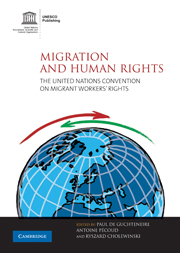Book contents
- Frontmatter
- Contents
- List of figures
- List of tables
- Notes on contributors
- Abbreviations
- 1 Introduction: The UN Convention on Migrant Workers' Rights
- PART I
- PART II
- 7 Obstacles to, and opportunities for, ratification of the ICRMW in Asia
- 8 Obstacles to ratification of the ICRMW in Canada
- 9 Mexico's role in promoting and implementing the ICRMW
- 10 Migrants' rights after apartheid: South African responses to the ICRMW
- 11 Policy on the ICRMW in the United Kingdom
- 12 The French political refusal on Europe's behalf
- 13 Migration and human rights in Germany
- 14 Migration and human rights in Italy: prospects for the ICRMW
- 15 The ICRMW and the European Union
- Annex 1 International Convention on the Protection of the Rights of All Migrant Workers and Members of Their Families Adopted by General Assembly Resolution 45/158 of 18 December 1990
- Annex 2 Ratifications of ILO Conventions 97 and 143 and of ICRMW as at June 2009
- Index
- References
7 - Obstacles to, and opportunities for, ratification of the ICRMW in Asia
Published online by Cambridge University Press: 02 December 2010
- Frontmatter
- Contents
- List of figures
- List of tables
- Notes on contributors
- Abbreviations
- 1 Introduction: The UN Convention on Migrant Workers' Rights
- PART I
- PART II
- 7 Obstacles to, and opportunities for, ratification of the ICRMW in Asia
- 8 Obstacles to ratification of the ICRMW in Canada
- 9 Mexico's role in promoting and implementing the ICRMW
- 10 Migrants' rights after apartheid: South African responses to the ICRMW
- 11 Policy on the ICRMW in the United Kingdom
- 12 The French political refusal on Europe's behalf
- 13 Migration and human rights in Germany
- 14 Migration and human rights in Italy: prospects for the ICRMW
- 15 The ICRMW and the European Union
- Annex 1 International Convention on the Protection of the Rights of All Migrant Workers and Members of Their Families Adopted by General Assembly Resolution 45/158 of 18 December 1990
- Annex 2 Ratifications of ILO Conventions 97 and 143 and of ICRMW as at June 2009
- Index
- References
Summary
Introduction
To date, among the forty-one States Parties that have ratified the ICRMW, three are situated in those parts of the Asian region under discussion here (South, South-East and East Asia): East Timor (in 2004), the Philippines (in 1995) and Sri Lanka (in 1996); with Bangladesh (in 1998), Cambodia and Indonesia (both in 2004) having signed only. The first two ratifications by Asian countries took place in the 1990s – the decade during which only twelve of the current forty-one ratifications occurred. The other twenty-nine countries have acceded since 2000. The Philippines was among the early signatories (1993) and was the first Asian country to ratify. This is not surprising considering that it participated in the deliberations during the Convention's drafting process in the early 1980s and had been a significant labour exporter since the mid 1970s. When looking at ratification rates from a cross-regional perspective, most of the current States Parties are located in Africa (seventeen ratifications), followed by South America (fourteen ratifications). In this respect, despite its overall population size and migration volume, Asia is surprisingly under-represented among States Parties. This is, however, consistent with Asia's overall low rate of ratifications of all UN conventions and covenants, where it takes bottom position. Yet, one phenomenon consistent with the rest of the world is that, so far, no migrant receiving country in Asia has ratified the ICRMW.
- Type
- Chapter
- Information
- Migration and Human RightsThe United Nations Convention on Migrant Workers' Rights, pp. 171 - 192Publisher: Cambridge University PressPrint publication year: 2009
References
- 4
- Cited by

